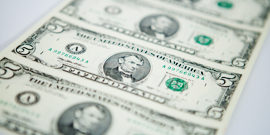Until 1857 all US $ bills were printed using ‘carbon black’ based ink on both the front and reverse of the note.
The colour green used on US currency was invented in 1857 by a Canadian chemist named Thomas Sterry Hunt. Like other chemists of his day, he used natural pigments and laboratory chemicals to develop new colours. In this case he used chromium trioxide to create this new green ink.
In the mid-19th Century it was common for counterfeiters to erase the black numerals on paper money (the part that tells you how much it’s worth) and then reprint them with a higher denomination numeral.
Unlike other inks of that period, Hunt’s new ink was extremely difficult to erase, and because it was not black this green ink could not be photographed. Mr Hunt’s ink is also practically indestructible; acid won’t affect it and neither will most other chemical agents.
Mr Hunt sold his invention to the U.S. government and the green ink has been used since 1862 to print U.S. banknotes.
That is how American paper money became known all over the world as the “greenback.”







